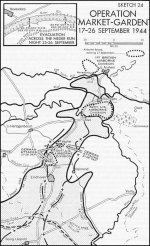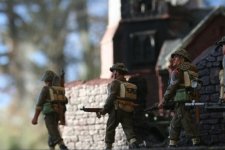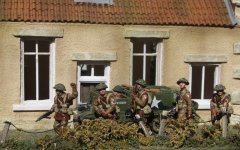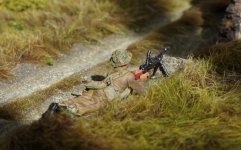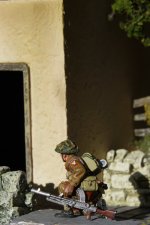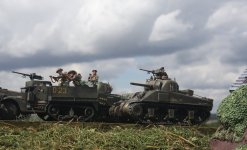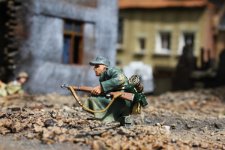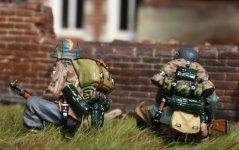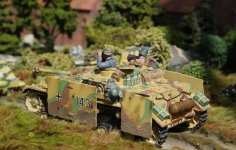You are using an out of date browser. It may not display this or other websites correctly.
You should upgrade or use an alternative browser.
You should upgrade or use an alternative browser.
Battle for Arnhem.... (1 Viewer)
- Thread starter panda1gen
- Start date
panda1gen
Colonel
- Joined
- Jul 29, 2005
- Messages
- 8,162
Very nice
Thanks, glad you like it. All the best.
panda1gen
Colonel
- Joined
- Jul 29, 2005
- Messages
- 8,162
Colonel Johnson matched the German commanders’ confidence and saw their arrival as a further opportunity to destroy another significant enemy force.
He planned to advance with 1/501 PIR from positions on the Canal near Heeswijk and with 3/501 PIR from Eerde, in order to drive the enemy into the guns of 502 PIR north of St Oedenrode.

Squadrons of British tanks from 44/Royal Tank Regiment (RTR), detached from 4 Armoured Brigade, were available to support the two American Regiments. B Squadron was allocated to support 501 PIR and A Squadron supported 502 PIR. C Squadron 15/19 Hussars was earmarked as the divisional reserve.
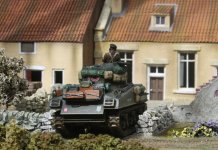
If successful, Colonel Johnson would repeat his previous day’s success by enveloping the enemy, but on a grander scale.
Night 21 - 22 September 1944
The advance began at 19.00 hours. Just as Lieutenant Colonel Kinnard was about to conduct a route recce, he unexpectedly received an order to,
‘Move now’.
He faced the prospect of carrying out,
‘a night assault on a strange city, filled with an unknown number of enemy’.
1/501 PIR set off in column of companies along the road, which was by far the quickest way of covering ground. A more circumspect advance, cross country, would have bogged down as infantry tried to cross drainage ditches in the darkness.
However, in the gathering gloom they were engaged by a vehicle mounted multiple 20mm anti-aircraft gun, supported by a machine gun in a nearby group of houses.
The paratroopers took to the drainage ditches for cover. From there, they manoeuvred into better positions. After a sharp fire fight, they forced the Germans to withdraw.
Private First Class Beckerman remembered that:
‘We were crossing many open fields under German fire, hearing the small arms fire whizzing by and making a thud sound as they hit the ground near you. Luckily, none of them had my name on them. I remember chasing a group down the road. They had a 20mm anti-aircraft gun. They would stop around a bend and wait for us to come near, fire a clip point blank at us and then take off.’
The 1st Battalion advanced two miles with fixed bayonets and took Schijndel without significant incident by midnight. The battalion found only a few surprised Germans and it was considered secure by 01.50 hours.

Colonel Johnson said,
‘The large German groups, reported earlier, had evidently moved on to the south’.
At his request, members of the resistance set out on their bicycles on highly dangerous missions to locate the enemy. Meanwhile, the Dutch Resistance reported that the 3rd Battalion, advancing on Schijndel from Eerde, would encounter ,
‘a sizable blocking force at the railway station’.
This position took some time to overcome and the withdrawing Germans mounted a determined resistance. 3/501 PIR finally arrived in Schijndel well after dawn. Sergeant Chapman wrote about dawn on 22 September:
‘We took the town filled with enemy soldiers. In the morning, [heavy sleeping!] Krauts came out of bedrooms to walk into our guys in the kitchen.’
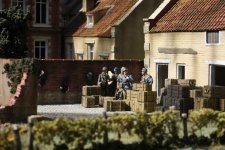
The town’ perimeter bristled with paratroopers and Private Carpenter recalled how:
‘In the morning, we set up some roadblocks on the roads leading into Schijndel from the north, east and west. These started paying dividends right away as word hadn’t gotten back to the German vehicles as they arrived in that little town.’
Lieutenant Howard and his platoon from Company C,
‘were having a field day against enemy vehicles coming in from the west’.

He urged his men to,
‘Shoot high so you can knock off those men without ruining a good motor car’.
Almost any transport was useful to paratroopers who could otherwise only manoeuvre at walking pace.
panda1gen
Colonel
- Joined
- Jul 29, 2005
- Messages
- 8,162
Ref: Battleground Europe - Operation Market Garden
Hell’s Highway - By Tim Saunders
Schijndel – Friday 22 September 1944
While Company C was busy capturing unsuspecting Germans arriving from s’Hertogenbosch, the enemy facing the rest of 1/501PIR, were very aware of the American occupation of the town. This was not particularly conducive to Colonel Johnson’s plan to envelop them. Accordingly, at 07.15 hours, Company B (in positions on the southern edge of the town) reported the arrival of a force of,
‘two hundred infantry supported by two tanks’.

The ‘tanks’ were probably two of the Jagdpanthers seen the previous evening.
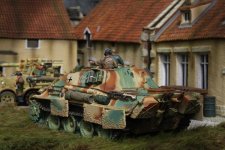
Company B was outnumbered and soon in trouble. Its most forward platoon was being driven in. Lieutenant Colonel Kinnard called for fire support but the observer in the church spire, could see nothing through the early autumn ground mist.
The Jagdpanthers were heavier, so better armoured and armed compared to the Allied Shermans. However, weighing in at forty-seven tons, the Jagdpanthers were unable to traverse the soft Dutch ground without sinking into the polder, so they were confined to the road. They advanced to within two-hundred yards of the paratroopers’ roadblocks at the town’s edge.
With the words,
‘We’re heading that way. I think we can get them from the flank’,
Company B commander, Lieutenant Hamilton, led his reserve platoon forward. His idea was recorded in the after-action report:
‘to make an end run around the buildings to his right, emerge on the line of the enemy advance between the main body and the advance party, take the latter in the rear and so bring the whole movement into check.’

Accordingly, Lieutenant Hamilton positioned one section to pin down the enemy’s main body while his other two sections engaged the leading group of Germans. The paratroops moved through a nunnery and farm buildings, then shot the lock off a large gate, so that they were able to emerge into the street. Even though the Germans were advancing cautiously, they still managed to take them by surprise.

After ten Germans were shot and with the aggressive American paratroops unexpectedly deployed in their rear, the remaining twenty men of this leading group surrendered. The advance of the enemy main body had been halted by Lieutenant Hamilton’s well executed tactical manoeuvre. He had stopped a significantly superior force without resorting to a positional defence that would probably have been more costly.
Hell’s Highway - By Tim Saunders
Schijndel – Friday 22 September 1944
While Company C was busy capturing unsuspecting Germans arriving from s’Hertogenbosch, the enemy facing the rest of 1/501PIR, were very aware of the American occupation of the town. This was not particularly conducive to Colonel Johnson’s plan to envelop them. Accordingly, at 07.15 hours, Company B (in positions on the southern edge of the town) reported the arrival of a force of,
‘two hundred infantry supported by two tanks’.

The ‘tanks’ were probably two of the Jagdpanthers seen the previous evening.

Company B was outnumbered and soon in trouble. Its most forward platoon was being driven in. Lieutenant Colonel Kinnard called for fire support but the observer in the church spire, could see nothing through the early autumn ground mist.
The Jagdpanthers were heavier, so better armoured and armed compared to the Allied Shermans. However, weighing in at forty-seven tons, the Jagdpanthers were unable to traverse the soft Dutch ground without sinking into the polder, so they were confined to the road. They advanced to within two-hundred yards of the paratroopers’ roadblocks at the town’s edge.
With the words,
‘We’re heading that way. I think we can get them from the flank’,
Company B commander, Lieutenant Hamilton, led his reserve platoon forward. His idea was recorded in the after-action report:
‘to make an end run around the buildings to his right, emerge on the line of the enemy advance between the main body and the advance party, take the latter in the rear and so bring the whole movement into check.’

Accordingly, Lieutenant Hamilton positioned one section to pin down the enemy’s main body while his other two sections engaged the leading group of Germans. The paratroops moved through a nunnery and farm buildings, then shot the lock off a large gate, so that they were able to emerge into the street. Even though the Germans were advancing cautiously, they still managed to take them by surprise.

After ten Germans were shot and with the aggressive American paratroops unexpectedly deployed in their rear, the remaining twenty men of this leading group surrendered. The advance of the enemy main body had been halted by Lieutenant Hamilton’s well executed tactical manoeuvre. He had stopped a significantly superior force without resorting to a positional defence that would probably have been more costly.
panda1gen
Colonel
- Joined
- Jul 29, 2005
- Messages
- 8,162
Ref: Battleground Europe - Operation Market Garden
Hell’s Highway - By Tim Saunders
Things did not fare so well elsewhere in Schijndel as 1/501 PIR’s positions were penetrated. The situation was only restored, at 09.30 hours, by the arrival of 3/501 PIR in support.

Meanwhile Company A, who defended the eastern part of the town, came under attack.

The enemy force advanced along the Koveringse Dike road.
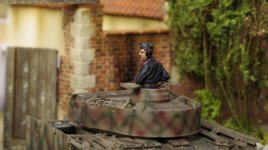
The tanks were kept at bay by bazooka fire .... but the paratroops could not stop groups of German infantry from infiltrating into the town, using the ditches and buildings as cover.

Hell’s Highway - By Tim Saunders
Things did not fare so well elsewhere in Schijndel as 1/501 PIR’s positions were penetrated. The situation was only restored, at 09.30 hours, by the arrival of 3/501 PIR in support.

Meanwhile Company A, who defended the eastern part of the town, came under attack.

The enemy force advanced along the Koveringse Dike road.

The tanks were kept at bay by bazooka fire .... but the paratroops could not stop groups of German infantry from infiltrating into the town, using the ditches and buildings as cover.

panda1gen
Colonel
- Joined
- Jul 29, 2005
- Messages
- 8,162
Fortunately, the Germans never assembled in sufficient strength to hold their gains against the American paratroops.
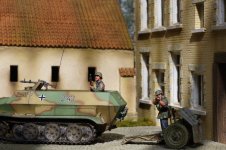
Whilst the Germans were driven out of their footholds in the town, the Americans lacked sufficient combat power to drive them off completely, so a stalemate developed.
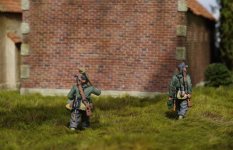
German armour shelled the Americans and they replied with bazooka rounds.

Then Colonel Johnson and a squadron of British tanks from B Squadron 44/ RTR arrived and the situation improved. By now, the morning mist had also burnt off, so the spotters could now see to direct the 101st’s artillery. This opened fire from the area of St Oedenrode, although the guns were themselves in danger of attack.
44/RTR’s Intelligence Officer, Captain Joe Arsenault, recalled:
‘B Squadron had started their southerly move from Schijndel by brassing up some ammo trucks – much to the annoyance of the paratroopers, who wanted to use them as transport – but later were engaged by some 88mm guns from the left flank. These were smartly dealt with by the para-boys who bazooka’d the guns and shot the crews.’

However, clearing the Germans away from Schijndel delayed 501 PIR’s advance. Their line of departure was on the railway line to the south of the town.
The divisional historian recorded,
‘The 1st Battalion drew abreast of 3rd along the railroad line at 1330 and the attack jumped off. The 3rd Battalion was well to the left of the highway, but as the ground was perfectly flat, the gap between the two battalions did not become a source of trouble. Advance was swift. From behind the infantry, the [British] tanks engaged the German strong points. As fast as these were softened up the [American] infantry groups moved up their ditches to places where they could be brought under small-arms fire, or wracked with grenades, and then overwhelm them. In the first hour twenty-five enemy were killed and forty-five captured, with a loss to that [1st] battalion of only eight casualties. Although the men had been on the go for twenty-four hours, this was heady stuff.’


Whilst the Germans were driven out of their footholds in the town, the Americans lacked sufficient combat power to drive them off completely, so a stalemate developed.

German armour shelled the Americans and they replied with bazooka rounds.

Then Colonel Johnson and a squadron of British tanks from B Squadron 44/ RTR arrived and the situation improved. By now, the morning mist had also burnt off, so the spotters could now see to direct the 101st’s artillery. This opened fire from the area of St Oedenrode, although the guns were themselves in danger of attack.
44/RTR’s Intelligence Officer, Captain Joe Arsenault, recalled:
‘B Squadron had started their southerly move from Schijndel by brassing up some ammo trucks – much to the annoyance of the paratroopers, who wanted to use them as transport – but later were engaged by some 88mm guns from the left flank. These were smartly dealt with by the para-boys who bazooka’d the guns and shot the crews.’

However, clearing the Germans away from Schijndel delayed 501 PIR’s advance. Their line of departure was on the railway line to the south of the town.
The divisional historian recorded,
‘The 1st Battalion drew abreast of 3rd along the railroad line at 1330 and the attack jumped off. The 3rd Battalion was well to the left of the highway, but as the ground was perfectly flat, the gap between the two battalions did not become a source of trouble. Advance was swift. From behind the infantry, the [British] tanks engaged the German strong points. As fast as these were softened up the [American] infantry groups moved up their ditches to places where they could be brought under small-arms fire, or wracked with grenades, and then overwhelm them. In the first hour twenty-five enemy were killed and forty-five captured, with a loss to that [1st] battalion of only eight casualties. Although the men had been on the go for twenty-four hours, this was heady stuff.’

villagehorse
Lieutenant General
- Joined
- Feb 5, 2010
- Messages
- 16,683
Kevin your forward planning of dio pieces to match the script seems to me, daunting, but you take in your stride, amazing. Robin.
panda1gen
Colonel
- Joined
- Jul 29, 2005
- Messages
- 8,162
Kevin your forward planning of dio pieces to match the script seems to me, daunting, but you take in your stride, amazing. Robin.
Thanks Robin but there is less planning than may appear.
Ref: Battleground Europe - Operation Market Garden
Hell’s Highway - By Tim Saunders
At 14.30 hours, 501 and 502 PIR and their British armour support were in position to spring their trap and encircle the enemy between Schijndel and St Oedenrode.

Then came the news that the enemy had cut Hell’s Highway north east of Veghel. The Allied advance to Arnhem was therefore halted.
The 101st’s divisional historian recorded:
‘Thus D Plus 5 [22 September], rather than being the story of a successful attack, became the story of a desperate defence … to ward off disaster’.
The situation necessitated that 501 PIR should withdraw towards Schijndel. They took with them one hundred and twenty-five prisoners, a mixed bag from the 1[SUP]st[/SUP] Fallschirmjäger Regiment and the 49th and 59th Grenadier Divisions. However, Schijndel had to be abandoned, as 101[SUP]st[/SUP] Airborne’s mission was to keep Hell’s Highway open, not to hold ground on the flanks of the advance.
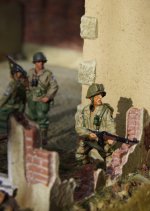
Veghel was vital, so Colonel Johnson ordered 3/501 PIR to move to Eerde immediately and,
‘In an unusual military movement Colonel Ewell halted his battalion’s attack, had all his men execute left face, and walked them off the battlefield with their right flank entirely exposed. The Germans by that time were so disorganized that the battalion got away with it.’

This 3/501 PIR withdrawal left 1/501 PIR exposed. 1/501 PIR had a difficult time getting back to Schijndel, but by 18.00 hours they were compelled to abandon it, leaving 170 wounded Germans they had captured during the day.
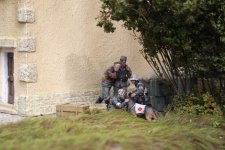
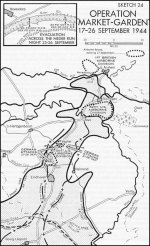
panda1gen
Colonel
- Joined
- Jul 29, 2005
- Messages
- 8,162
Ref: Battleground Europe - Operation Market Garden
Hell’s Highway - By Tim Saunders
107 Panzer Brigade’s two attacks against the 101[SUP]st[/SUP] on 19 and 20 September cut the road and significantly, and perhaps fatally, prevented the timely reinforcement and re-supply of Guards Armoured Division.
(I covered the attacks on Son Bridge from p.137 of this thread)
This involved getting their most powerful weapon – their Panthers – repaired and re-armed for the battle.
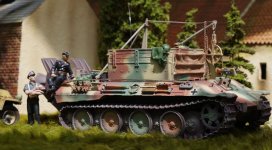

The infantry support would be busy trying to keep the paratroops away from the tanks.

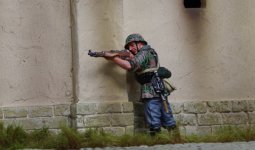

Hell’s Highway - By Tim Saunders
107 Panzer Brigade’s two attacks against the 101[SUP]st[/SUP] on 19 and 20 September cut the road and significantly, and perhaps fatally, prevented the timely reinforcement and re-supply of Guards Armoured Division.
(I covered the attacks on Son Bridge from p.137 of this thread)
This involved getting their most powerful weapon – their Panthers – repaired and re-armed for the battle.


The infantry support would be busy trying to keep the paratroops away from the tanks.



panda1gen
Colonel
- Joined
- Jul 29, 2005
- Messages
- 8,162
On the morning of 22 September, the only US paratroopers north of Veghel were the leading elements of 506 PIR - and these were of only company strength.

There now occurred the third, and probably the most significant, cut of Hell’s Highway, which took place on D Plus 5.
Generaloberst Student ordered 59th Division’s Kampfgruppe Huber, supported by troops from other formations (including Fallschirmjäger), to prepare to attack Hell’s Highway from the west.
From the German perspective, the operations by 501 and 502 PIR described previously between Veghel, Schijndel and St Oedenrode disrupted this part of the German plan.
Additionally, Oberstleutnant von der Hydte’s 6 Fallschirmjäger Regiment was also delayed and only joined the later stages of the battle.
Kampfgruppe Walther was under the control of LXXVI Corps and was far more successful in its attack mounted from the east. The attack was carried out at divisional strength and was successful mainly because the 101[SUP]st[/SUP] were overextended.




The 101[SUP]st[/SUP] after-action report highlights that,
‘it was impossible to be strong everywhere’.

There now occurred the third, and probably the most significant, cut of Hell’s Highway, which took place on D Plus 5.
Generaloberst Student ordered 59th Division’s Kampfgruppe Huber, supported by troops from other formations (including Fallschirmjäger), to prepare to attack Hell’s Highway from the west.
From the German perspective, the operations by 501 and 502 PIR described previously between Veghel, Schijndel and St Oedenrode disrupted this part of the German plan.
Additionally, Oberstleutnant von der Hydte’s 6 Fallschirmjäger Regiment was also delayed and only joined the later stages of the battle.
Kampfgruppe Walther was under the control of LXXVI Corps and was far more successful in its attack mounted from the east. The attack was carried out at divisional strength and was successful mainly because the 101[SUP]st[/SUP] were overextended.




The 101[SUP]st[/SUP] after-action report highlights that,
‘it was impossible to be strong everywhere’.
panda1gen
Colonel
- Joined
- Jul 29, 2005
- Messages
- 8,162
Friday 22 September 1944
By now the crossings of the Waal were secured by the 82[SUP]nd[/SUP] with Guards support.
However, the vulnerability of the narrow XXX Corps logistical corridor was now exploited by the German attacks. Supply columns and reinforcements necessary to sustain offensive operations were completely blocked for as long as the Germans kept traffic halted on Hell’s Highway.

By cutting Hell’s Highway, they also caused severe traffic jams along it. Traffic was ‘nose to tail’.


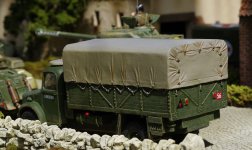
As it was still the main artery of XXX Corps, the forward movement of vital supplies was further reduced at a crucial time and caused a corresponding reduction in fighting efficiency of the attacking Allied formations.

For example, with the closure of Hell’s Highway on 22 September, 43rd Wessex Division was starved of supplies and this had a significant effect on the strength of its attack across ‘the Island’ towards Arnhem.
By now the crossings of the Waal were secured by the 82[SUP]nd[/SUP] with Guards support.
However, the vulnerability of the narrow XXX Corps logistical corridor was now exploited by the German attacks. Supply columns and reinforcements necessary to sustain offensive operations were completely blocked for as long as the Germans kept traffic halted on Hell’s Highway.

By cutting Hell’s Highway, they also caused severe traffic jams along it. Traffic was ‘nose to tail’.



As it was still the main artery of XXX Corps, the forward movement of vital supplies was further reduced at a crucial time and caused a corresponding reduction in fighting efficiency of the attacking Allied formations.

For example, with the closure of Hell’s Highway on 22 September, 43rd Wessex Division was starved of supplies and this had a significant effect on the strength of its attack across ‘the Island’ towards Arnhem.
panda1gen
Colonel
- Joined
- Jul 29, 2005
- Messages
- 8,162
German tactics by now included the well established ability to fight effectively by combining mixed elements into a ‘Kampfgruppe’. This flexibility in leadership and deployment was by 1944 a common occurrence.

By dawn on 22 September, Kampfgruppe Walther had assembled its mixed grouping of troops and was ready to attack.

SS-HauptsturmführerRichter commanded a battalion of SS infantry.
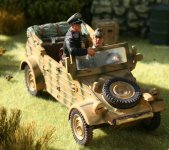
This consisted of three companies from the 1/22 SS Panzer Grenadiers detached from the 10th (Frundsberg) SS Panzer Division and formed up astride the Gemert to Erp road.


By dawn on 22 September, Kampfgruppe Walther had assembled its mixed grouping of troops and was ready to attack.

SS-HauptsturmführerRichter commanded a battalion of SS infantry.

This consisted of three companies from the 1/22 SS Panzer Grenadiers detached from the 10th (Frundsberg) SS Panzer Division and formed up astride the Gemert to Erp road.

panda1gen
Colonel
- Joined
- Jul 29, 2005
- Messages
- 8,162
The plan was for six Wehrmacht Panthers detached from 107 Panzer Brigade to support the two companies that would lead the attack.
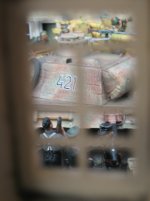
Richter ordered his third and weakest company to attack towards Veghel along the road on the northern bank of the canal. Their armour support would come from three of Roestel’s Stug IV assault guns (from their own 10[SUP]th[/SUP] SS Panzer Division).

A Wehrmacht armoured engineer company (mounted in half-tracks) was detached from 107 Panzer Brigade and would follow as an infantry reserve.
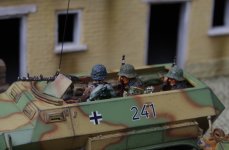

Richter’s adjutant, SS-Obersturmführer Heinz Damaske, described the ground across which the SS-Kampfgruppe would attack:
‘The terrain was unfavourable, 700 to 800 metres of practically no cover over meadowland, then thick scrub with the occasional tree for something like a half-kilometre to the Uden Veghel road.’
In addition, as discussed earlier, the River Aa’s flood plain provided only limited corridors for armoured manoeuvre.


Richter ordered his third and weakest company to attack towards Veghel along the road on the northern bank of the canal. Their armour support would come from three of Roestel’s Stug IV assault guns (from their own 10[SUP]th[/SUP] SS Panzer Division).

A Wehrmacht armoured engineer company (mounted in half-tracks) was detached from 107 Panzer Brigade and would follow as an infantry reserve.


Richter’s adjutant, SS-Obersturmführer Heinz Damaske, described the ground across which the SS-Kampfgruppe would attack:
‘The terrain was unfavourable, 700 to 800 metres of practically no cover over meadowland, then thick scrub with the occasional tree for something like a half-kilometre to the Uden Veghel road.’
In addition, as discussed earlier, the River Aa’s flood plain provided only limited corridors for armoured manoeuvre.

panda1gen
Colonel
- Joined
- Jul 29, 2005
- Messages
- 8,162
Kampfgruppe Walther’s main armoured strength was based on higher ground to the north. It was ordered to approach Veghel from the north-east.
This group of the Kampfgruppe was built around the Panther and panzer grenadier battalions of Major von Maltzahn’s 107 Panzer Brigade. Despite the two earlier actions at the Son Bridge, they were still at ninety percent of their original strength.




Oberst Walther’s orders were to capture Veghel and blow the four bridges. This action should block the road long enough for the Allied divisions to the north to be destroyed. Even if they could not hold Veghel itself for long, the Germans correctly believed the destruction of the bridges would impose vital delay to reinforcements.
SS-Obersturmführer Damaske noted that there was only logistic traffic on the Corridor,
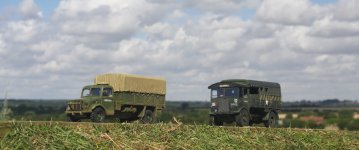
‘the enemy had obviously not noticed the forming up point and on both sides of the [Gemert to Erp] road, we quickly made progress against weak resistance’.
Erp was captured and the advance continued. Kampfgruppe Walther quickly established itself on two miles, of Hell’s Highway, immediately north of Veghel. By 11.00 hours, plumes of smoke from burning trucks marked the area of attack and 107 Panzer Brigade and SS-HauptsturmführerRichter’s Kampfgruppeprepared to launch the final phase of their attack by assaulting Veghel and its bridges.
This group of the Kampfgruppe was built around the Panther and panzer grenadier battalions of Major von Maltzahn’s 107 Panzer Brigade. Despite the two earlier actions at the Son Bridge, they were still at ninety percent of their original strength.




Oberst Walther’s orders were to capture Veghel and blow the four bridges. This action should block the road long enough for the Allied divisions to the north to be destroyed. Even if they could not hold Veghel itself for long, the Germans correctly believed the destruction of the bridges would impose vital delay to reinforcements.
SS-Obersturmführer Damaske noted that there was only logistic traffic on the Corridor,

‘the enemy had obviously not noticed the forming up point and on both sides of the [Gemert to Erp] road, we quickly made progress against weak resistance’.
Erp was captured and the advance continued. Kampfgruppe Walther quickly established itself on two miles, of Hell’s Highway, immediately north of Veghel. By 11.00 hours, plumes of smoke from burning trucks marked the area of attack and 107 Panzer Brigade and SS-HauptsturmführerRichter’s Kampfgruppeprepared to launch the final phase of their attack by assaulting Veghel and its bridges.
panda1gen
Colonel
- Joined
- Jul 29, 2005
- Messages
- 8,162
As briefly discussed earlier, SS-Hauptsturmführer Richter organised his attack on Veghel ....

.... using his battalion of SS infantry (three companies from the 1/22 SS Panzer Grenadiers detached from the 10th (Frundsberg) SS Panzer Division.


Two companies attacked with six Wehrmacht Panthers detached from 107 Panzer Brigade in support.



.... using his battalion of SS infantry (three companies from the 1/22 SS Panzer Grenadiers detached from the 10th (Frundsberg) SS Panzer Division.


Two companies attacked with six Wehrmacht Panthers detached from 107 Panzer Brigade in support.


panda1gen
Colonel
- Joined
- Jul 29, 2005
- Messages
- 8,162
Ref: Battleground Europe - Operation Market Garden
Hell’s Highway - By Tim Saunders
The British Reaction
107 Panzer Brigade and SS-HauptsturmführerRichter’s KampfgruppeWalther attack struck a nose to tail stream of XXX Corps vehicles on Hell’s Highway.

Lieutenant Colonel McCance,

the officer responsible for supplying 43rd Wessex Division, recorded how:
‘The Divisional B Echelon, reinforced by Corps [logistic] troops, was split by the German road block between Veghel and Uden on 22nd September. We lost a significant number of our undefended RASC vehicles – there were no troops picketing the route and precious few escorts.
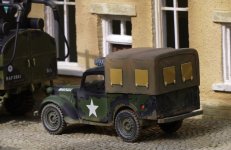
Club Route was closed for twenty-five hours and, consequently, the supply situation on the Island became critical. I am convinced that this prevented an early crossing of the Rhine by the Division to relieve the Airborne.’
Hell’s Highway - By Tim Saunders
The British Reaction
107 Panzer Brigade and SS-HauptsturmführerRichter’s KampfgruppeWalther attack struck a nose to tail stream of XXX Corps vehicles on Hell’s Highway.

Lieutenant Colonel McCance,

the officer responsible for supplying 43rd Wessex Division, recorded how:
‘The Divisional B Echelon, reinforced by Corps [logistic] troops, was split by the German road block between Veghel and Uden on 22nd September. We lost a significant number of our undefended RASC vehicles – there were no troops picketing the route and precious few escorts.

Club Route was closed for twenty-five hours and, consequently, the supply situation on the Island became critical. I am convinced that this prevented an early crossing of the Rhine by the Division to relieve the Airborne.’
panda1gen
Colonel
- Joined
- Jul 29, 2005
- Messages
- 8,162
[FONT="]Ref: Battleground Europe - Operation Market Garden [/FONT]
[FONT="]Hell’s Highway - By Tim Saunders[/FONT]
[FONT="] [/FONT]
[FONT="]Continued ....
Confusion reigned. The streets of Veghel were choked with cumbersome and heavily laden vehicles.
[/FONT]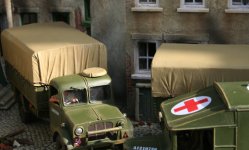
[FONT="] [/FONT]
[FONT="]Many convoy commanders were killed or stranded the on other side of the German roadblock.
[/FONT] [FONT="]
[FONT="]
[/FONT]
[FONT="]Hell’s Highway - By Tim Saunders[/FONT]
[FONT="] [/FONT]
[FONT="]Continued ....
Confusion reigned. The streets of Veghel were choked with cumbersome and heavily laden vehicles.
[/FONT]

[FONT="] [/FONT]
[FONT="]Many convoy commanders were killed or stranded the on other side of the German roadblock.
[/FONT]
 [FONT="]
[FONT="][/FONT]
Users who are viewing this thread
Total: 2 (members: 0, guests: 2)


